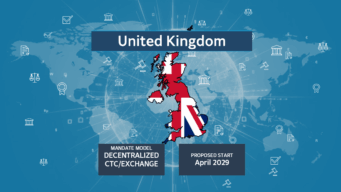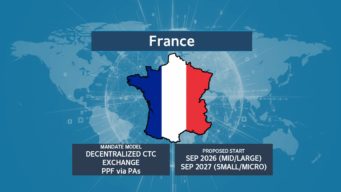
Introduction
Welcome to our regular e-Invoicing newsletter.
For our July newsletter we’ll take the opportunity to focus on some of the impending B2B e-Invoicing mandates in the European Union and compare their requirements in order to illustrate some of the challenges facing businesses, while also providing some best practice guidance on how to avoid the potential pitfalls.
The mandates in France, Poland, Serbia and Romania are hot topics amongst stakeholders from government, the private sector, the invoicing service provider community and the European commission.
While companies do have some time to prepare for the French and Polish mandates in 2023 and 2024 respectively, the Romanian and Seriban mandates are nearly upon us.
These mandates all share a common aim, namely to use e-Invoicing mandates to reduce the VAT gap and provide governments with greater visibility into the economy. At first glance this appears to be a good thing all round – potentially providing benefits for both business and government – but in practice national policy and technical preferences result in very different obligations for taxpayers in each country they operate in. The differences between each nations’ specific legislation and technical infrastructure pose challenges for all parties.
Let’s focus on France and Poland. While their e-Invoicing mandates have a common ambition the technical approach and requirements that have been published thus far differ significantly, as each country has to consider their own internal policies and expectations.
These discrepancies make things more complex for companies that have to set up compliance projects covering both countries at the same time. With different expectations and requirements these projects must be planned carefully to avoid potential risks, capitalize on the opportunities for process improvement and optimize both human and financial resources.
In this newsletter we will examine three key points where these countries diverge, and which may lead to additional complexity on the business side, namely: the timetable and mode of inception, the method of sending invoices, and the format of invoices.
1. Timeline and mode of inception
While France has opted for a phased schedule based on the size of each company and has provided plenty of notice in order to give companies time to prepare, Poland has opted for a big bang approach with a much shorter deadline.
France
There is a clear distinction between the timeline for outgoing and incoming invoices. When it comes to issuing invoices to your clients, the new obligations will take effect for you according to the size of your company. Large companies will have to issue all invoices electronically from July 2024, mid-size companies in January 2025, and SMEs and micro-enterprises in January 2026.
While on the face of it, the long preparation period granted to companies may appear to provide plenty of breathing space, as we write this in July 2022 the French tax authority has still failed to finalize key technical details, has not published all the relevant regulatory texts, nor have they issued all of the necessary decrees required to give the regulations weight in law. So there is a lack of certainty which leads to concerns about the feasibility of the schedule.
And while the gradual phasing in of these requirements on the surface seems to provide even more time at least for the majority of companies, the fact remains that all companies established in France must be ready to receive e-invoices sent by their suppliers from July 2024.
Of course, this makes perfect sense since the large enterprises mandated to send e-Invoices in phase 1 can in principle be issuing invoices to any size of business but it does mean that first deadline of July 1st 2024 effectively applies to all businesses.
Within larger enterprises, issuance and reception of e-Invoices is often performed by different applications owned by different departments – AP vs AR, purchasing/procurement versus sales, even potentially different applications for indirect materials procurement and direct materials and so ensuring that all applications and processes are in compliance by the correct date is imperative.
Poland
By contrast the Polish mandate imposes a “big bang” approach for both issuance and reception of e-Invoices. After an initial voluntary period which already came into effect back on 1 January 2022, the mandate comes into full force for all companies, regardless of size, from the second quarter of 2023.
The exact inception date of the reform is not yet finalized, which, given the short lead time, is of course going to cause concern for companies operating in Poland. This lack of communication of an official date could lead us to suspect that the Polish system is still not fully ready – but only time will tell.
The roll out of each of these two mandates will require careful planning, as companies will have to factor in these differences of approach – Poland’s tighter timeline and “big bang” leaves little time for businesses to prepare since all AP and AR processes will need to be integrated with the new KSeF portal and fully tested, while in France there is a longer lead time, and in principle companies could focus on the AP / invoice reception process in the first instance and leave invoice issuance / AR until a second phase.
The uncertainty that still exists in both countries remains a cause for concern. However this should not prevent companies from continuing with their preparations.
2. Method of sending and receiving e-invoices
A common feature of the systems envisaged by both France and Poland is the use of a central government portal which effectively puts an end to the direct exchange of invoices between the supplier and the buyer. While the French approach leaves some room for innovation by allowing private e-Invoicing providers to be part of the flow and manage the exchange of the invoice data, the Polish approach insists upon the mandatory use of a public portal.
France
Companies have two options for issuing and receiving e-invoices in France, either they may use an accredited private service provider (Plateforme de Dématérialisation Partenaire: PDP) or they can choose to directly use the E-invoicing Public Portal (Portail Public de facturation – PPF).
While use of the PPF is free, which of course may seem appealing, companies should note that according to the French tax administration themselves, this will only provide a minimal service. It is clearly targeted for microenterprises with limited technical infrastructure to ensure that there remains an affordable basic option. For SMEs and enterprises the use of a service provider such as OpenText is recommended.
Poland
To issue and receive e-invoices in Poland, companies will have to use the national portal called The National System of e-Invoices (Krajowy System e-Faktur: KSeF). The connection to KSeF can be done directly by the issuer or receiver of the invoices, by connecting their line of business applications to the portal – or else can be done by using a service provider such as OpenText.
The technical complexity imposed by these varying public portals – which will of course be increased when you are also trading in Italy, which has it’s own portal, or any of the many other countries who have followed the Latin American clearance model – imposes additional burdens on businesses and reduces the opportunities for automation and process improvement.
3. Format of e-invoices
The format of electronic invoices is another place where the French and Polish reforms diverge. While the Polish tax authorities are imposing the use of a single structured invoice format, the French tax authorities have opted to allow more freedom of choice by accepting various formats.
France
The French regulations allow for a number of different formats for the issuance of invoices, with multiple structured formats (UBL, CII, etc), unstructured formats (native PDF), or hybrid formats (Factur-X – the Franco-German collaboration based on the German ZUGFeRD format). This is also one of those areas where the direct usage of the public invoicing portal as discussed above in point 2 will limit the options.
For those choosing to issue their invoices directly via the PPF portal, only UBL, CII and Factur-x can be used, whereas the use of a service provider will allow companies to use other structured formats such as the widely used EDIAFCT standard for example.
The diversity of formats available for those using service providers will be a great benefit for companies already invoicing electronically since, potentially, it allows them the freedom to continue to use existing formats with very little change. But for those companies relatively new to e-Invoicing it presents greater complexity both for generating invoices and also for receiving and integrating various formats into their ERP and Accounts Payable applications.
The selection of one format rather than another for issuing or receiving invoices must be considered carefully in order to arrive at the best format to meets not only tax requirements but also the business and IT requirements/ constraints.
Businesses must remember that while there are many options, this does not suggest a laissez faire attitude to the content and structure of the invoice, which must still meet the mandatory guidelines.
Poland
Only one invoice format is allowed, namely the XML format (FA_VAT), whose syntax and semantic format is defined in the documentation published by the Polish tax authorities. As with the Italian FatturaPA model there are strict rules to be followed when creating the invoice for consumption via the KSeF portal, so if your ERP is not able to produce it, you will need to find alternative solutions to perform the format conversion such as a service provider.
It should be noted that the FA_VAT introduces entirely new obligations in terms of the content of the invoice, requiring not merely mandatory VAT content, but also payment information, transaction terms, and data related to settlement of customs duties,
A service provider like OpenText, with expertise in mapping and format conversion, can not only assist you in generating invoices in the format and content expected by tax authorities or your customers. But further, they can help to ensure that you are able to generate the data expected by the tax authorities.
Other considerations
While these are the three most significant points of divergence between the French and Polish e-Invoicing mandates it’s important to remember that there will certainly be many others. A detailed analysis of the requirements of each country you operate in is still an essential part of your e-Invoicing project, and this is another area where an experienced service provider can be invaluable.
Companies not used to invoicing electronically via centralized government portals like the PPF in France and KSeF in Poland may not realize the additional constraints that will be imposed on their existing business processes. For example, once an invoice is issued and passed to the portal it generally cannot be changed, which may mean your current invoice exception management processes will need to be changed. A service provider like OpenText can help minimize such exceptions by instituting business rules that prevent erroneous invoices being submitted in the first place.
Conclusion
Most companies that will be impacted by these two upcoming mandates are likely to have a number of different compliance projects already underway and resources may already be stretched. However, it is vital that you take the time to analyze the requirements carefully to identify potential risks as well as areas of opportunity to optimize existing processes to meet the mandates for these two countries, but also for the many other mandates following along behind.
It is also important to remember that, especially within larger enterprises, issuance and reception of e-Invoices is often performed by different applications owned by different departments – not merely AP vs AR, but potentially also direct materials purchasing vs indirect procurement vs sales. The owners of these systems and processes will need to co-operate to ensure that there is some uniformity and consistency in terms of implementing e-Invoicing across these different areas. If different solutions are being used you will need to ensure that each fully respects the different deadlines and mandatory obligations imposed while also meeting your business needs.
The use of a global service provider such as OpenText can assist you in optimizing all of your e-Invoicing compliance projects by outsourcing some of the more challenging steps. Your teams will analyze the impact of the upcoming regulations on your internal processes and our teams will manage the integration between your internal applications and each the government portal, the mapping and format conversion to the mandatory format, and business rules for data verification etc.
OpenText customers simply connect to our network and we extend your reach by means of our “business to anything” or B2A approach, connecting you not only to these government portals, but also directly to your trading partners in those countries that have not embraced the centralized model being imposed in France and Poland – and this still includes the vast majority of European countries and beyond. Extending the reach of your e-Invoicing program will greatly increase the ROI and deliver significant business benefits in terms of automation, reduced exceptions, and as a result improve your cashflow.
Contact your OpenText sales representative for further information about how to plan and prepare for these e-Invoicing mandates.




